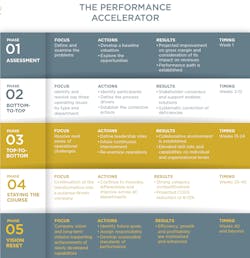The Impact of ESG: How To Overcome Productivity Headwinds
Formulating a positive strategy for sustainable productivity is one of the greatest challenges facing today’s manufacturers. In fact, the numbers can be sobering.
According to an August 9, 2022, Reuters report, “U.S. worker productivity in the second quarter fell at its steepest pace on an annual basis since 1948 when the Labor Department began tracking it, while growth in unit labor costs accelerated, suggesting strong wage pressures, will continue to help keep inflation elevated. Nonfarm productivity, which measures hourly output per worker, fell at a 2.5% pace from a year ago. It also declined sharply in the second quarter at a 4.6% annualized rate.”
If you have read any of my previous articles, you’ll know that not only am I a “half-full-glass” type of businessperson but that my optimism is buoyed by the pragmatic Tight Lines Advisors productivity platform, The Performance Accelerator. This values-driven transformational process for enhanced efficiency, performance, competitive positioning, and financial growth was developed to overcome precisely the type of challenges facing our economy today.
It’s been my experience that a holistic, pragmatic approach, which builds value creation for all stakeholders both internal and external, can be both inclusive and sustainable. A dynamic and comprehensive process, The Performance Accelerator recognizes that the most important component of successful companies and sustained market dominance is people. That’s because these organizations in both broad and individual industries who are truly motivated to mitigate their problems, empower their people to overcome those challenges, and evolve into world-class market leaders.
A workforce motivated and energized as meaningful participants in a company’s improvement and success remains, in my view, the most valuable asset in driving value creation. First and foremost, it must be done in an organized and goal-oriented manner.
Currently, challenging outside economic conditions persist both nationally and globally. When combined with a disjointed employment market, the adverse effects on the industrial manufacturing spectrum and beyond, persist. Productivity growth not only remains below pre-pandemic levels as noted in the Labor Department’s 2022 Q2 report, but that decline first became evident even before the financial crisis. When viewed in the context of technological advances over the last decade the deterioration can appear perplexing.
The confluence of leadership direction, workforce engagement, and performance-enhanced technologies under a unifying company vision and purpose breaks down the organizational barriers that can significantly inhibit performance. Unfortunately, productivity is far too frequently hampered by disengaged, fragmented teams. These siloed units are all too often programmed and rewarded to do what is right for their group regardless of the company in its entirety. From the executive offices, top-down, organizational directives issued in a knee-jerk, “issue du jour” manner can do additional harm to disenfranchise and disillusion the stakeholder workforce in their belief as valued partners and contributors to company success.
Teams, while they can be experienced as well as diverse, are intentionally separated from each other and may seek to resolve similar issues with completely different methodologies and solutions. It can result in disorganized actions with negative impacts between functions, especially if there are no feedback loops in either the operational actions or decision-making. Consequently, a siloed approach to operations is simply not viable or sustainable.
Further complicating the path to accelerated performance and productivity has been the ascendancy of Environmental Social and Governance (ESG). In its early stages, ESG was referred to as a generic term used in capital markets and by investors to evaluate corporate behavior and to determine the projected fiscal performance abilities of a company. Increasingly, traditional investors are becoming interested in utilizing the framework of ESG more broadly. Many have begun using its ground rules for determining financial risk in more overall investment decision-making processes.
More recently, the acronym has expanded to incorporate a number of non-financial performance indicators including sustainable, ethical, and corporate governance issues like diminishing a company’s carbon footprint and verifying there are systems in place to ensure standardized operational accountability. Under these protracted considerations and metrics, sustainability, productivity, and value-creation have the potential to either blossom or wither on the vine, so to speak. It’s a path that manufacturing companies must carefully navigate.
Sustainability and ESG have a number of opposing forces. For instance, the culture of sustainability and ESG has resulted in the formation of what some characterize as “groupthink,” a mindset that is process-focused rather than outcome-focused and measured (the effectiveness of process). And in business, everything is a process and everyone can be measured by their accuracy/quality, time, and cost. As a result, the procedure narrows itself to diagnosing problems rather than continuing to a more complete, and beneficial outcome of offering scalable practical solutions.
To remedy this potential drawback, an “inside-out approach” like that of The Performance Accelerator champions an unbundling of managerial and operational “territories.” This unification further expands the decision space of all internal stakeholders and recognizes contributions in recognizing issues, solving problems, instituting efficiencies, and driving economic efficiencies.
Under the “E” in ESG, operational efficiencies sought in a companywide improvement call for conformity with environmental goals and norms, which are often referred to by the term “circular economy.” The EPA describes the concept of a circular economy as one “…that uses a systems-focused approach and involves industrial processes and economic activities that are restorative or regenerative by design, enables resources used in such processes and activities to maintain their highest value for as long as possible, and aims for the elimination of waste through the superior design of materials, products, and systems (including business models).
I am a firm believer that a ‘net-zero’ economy is not only vital and necessary but economically feasible and beneficial. Reflecting this are the “bottom-to-top” and “top-to-bottom” stages of The Performance Accelerator that are inherently designed to address the environmental aspects contained in ESG. Incorporating an end-to-end approach, these phases identify and recommend systematic correction of deficiencies and resolve challenges by department and type. The continuation of these improvements and efficiencies enables long-term environmental responsibility.
As time goes on, Investors are projected to increasingly weigh ESG considerations when making capital allocation decisions. This is not without its risks, however, as reconciling sustainability goals and ROI objectives could prove to be elusive. Placing a heavy emphasis on the former may unintentionally hinder the outcome of the latter, and vice versa.
Social criteria—the “S” in ESG—looks at how a company treats people and places emphasis on employee relations, diversity, health and wellbeing, safety, and conflict resolution. This is another level of due diligence incorporated in the earliest stages of The Performance Accelerator, which identify workforce participants and seeks stakeholder involvement and consensus to address the technological, operational, and social issues that an organization needs to mitigate on its path to competitive positioning and productivity growth.
This growth is enabled through access to better information and the application of knowledge across the expanded decision spaces in the workforce. Decision space is defined by how much authority for making decisions on different functions is delegated to people throughout the organizational hierarchy. As a result, firms with a valued and engaged workforce often tend to be selective in their hiring practices. Better able to attract and retain employees who share the organization’s core values, the benefits may be experienced in higher levels of efficiency and increased labor productivity.
However, these results are not guaranteed. Companies that pursue a strategy of increasing “E” (environmental) and “S” (social) performance must be deliberate and vigilant. Reallocating productive resources like labor and capital to the production of ESG outcomes has the potential to decrease the resources available for revenue-producing capacity and activities, including improved total compensation for all employees.
Fortunately, the initiatives and the calculable outcomes that are inherent in each of the five steps in the Tight Lines Performance Accelerator program maximize workforce productivity while reducing waste and inefficiencies while enhancing the bottom line and profitability, and concurrently, further developing the capabilities of the individual/employee and the company. These advancements in operations and value creation provide the ability to reduce and neutralize the negative consequences of resource reallocations delegated to address both “E” and “S.”
Governance, the “G” in ESG predominately concerns itself with the leadership and managerial functions of the company. Beyond board structure and diversity, tax strategy, and executive compensation, governance also encompasses the implementation of strategic and tactical decisions that generate sustainable productivity and value creation. As part of The Performance Accelerator’s platform, an organization’s leaders are instrumental as the initiators of this transformational process as well as the champions of its enduring mission. They also perform additional duties as promoters of the process and advocates for all the people involved.
While it has long been recognized that ESG can affect a company’s valuation and financial performance, the application of its strategies is not a guarantee of superior performance or value creation over the long term. For all the projections and glowing promises of ESG advocates, that you can do well and do good simultaneously, there is little if any hard evidence of substantive benefits. Some investor advocates presume returns can be realized while pursuing a panoply of climate change actions and income regulating issues. However, studies commissioned recently by a number of prominent academic business schools are reporting that these predictions look to have been made through a pair of rose-colored glasses.
In my view, instituting the transformational, integrated approach of The Performance Accelerator combined with the pragmatic inclusion of appropriate and relevant ESG principles can make for a prudent, forward-leaning plan of action. Purposefully applied, it will drive productivity and value creation while helping to temper the outside forces and existential challenges that today’s companies face.
More and more, I’m having conversations with business executives about value creation, sustainable profitability, and the impact of ESG. These discussions are often spirited and eye-opening but always lead to new insights and greater opportunities. If you would like to talk about any or all of what you’ve read, I invite you to contact me.
Founded by John Abplanalp, a longtime avid fly fisherman with a love of all things nautical, the Tight Lines Advisors, LLC name accurately reflects his unique methodology. It refers to the success that is realized when the dynamic strategy and process are effectively applied and everyone in the organization ‘pulls together’ creating the Tight Lines effect of synergy and efficiency. Tight Lines Advisors' methodology takes an “inside out” approach that focuses on working in close partnership. Clients implement sustainable process changes, drive greater productivity, and expand capabilities, all while reducing costs. This focus increases product performance and reliability while establishing and improving customer relationships.
About the Author
John Abplanalp
President & Principal Consultant, Tight Lines Advisors, LLC
John Abplanalp has spent more than 35 years in manufacturing. He is an experienced, respected industry leader and innovator who has learned from the bottom up. John began as an assembly mechanic responsible for the setup and maintenance of the aerosol valve assembly lines, most recently serving as CEO and President of Precision Valve Corporation from 2003 to 2013 and Chairman of the Board from 2013 to 2015.
During the time in between, John attended college receiving an undergraduate degree in mechanical engineering from Manhattan College and an MBA from Fordham University. Returning from college he was awarded a position in the corporate offices as a business analyst reviewing various business ventures held by Precision.
In 1989, he was promoted to Vice President of North American Operations and developed and implemented Total Quality Management programs throughout the Precision Valve Corporation. Through his leadership, the sales of Precision Valve Corporation increased from $250 million in 2003 to $343 million in 2008, a 37% increase in revenue over a brief five-year period.
John’s broad expertise and experience in strategic planning, management, Overall Equipment Effectiveness (OEE), operational improvement, plant facilities layout/design, and international business provides an extensive knowledge base to assist clients in overcoming their challenges.
John served on the Executive Board of the Consumer Specialty Products Association from 2002 to 2015, including positions as Chairman and Assistant Treasurer. Throughout his career, he has been a tireless advocate and ambassador for the aerosol products industry.
John has been married to his wife, Tonina, for 24 years. They have two children.
Founded by John Abplanalp, a longtime avid fly fisherman with a love of all things nautical, the Tight Lines Advisors, LLC name accurately reflects his unique methodology. Tight Lines Advisors' methodology takes an “inside out” approach that focuses on working in close partnership. Clients implement sustainable process changes, drive greater productivity, and expand capabilities, all while reducing costs. This focus increases product performance and reliability while establishing and improving customer relationships.

